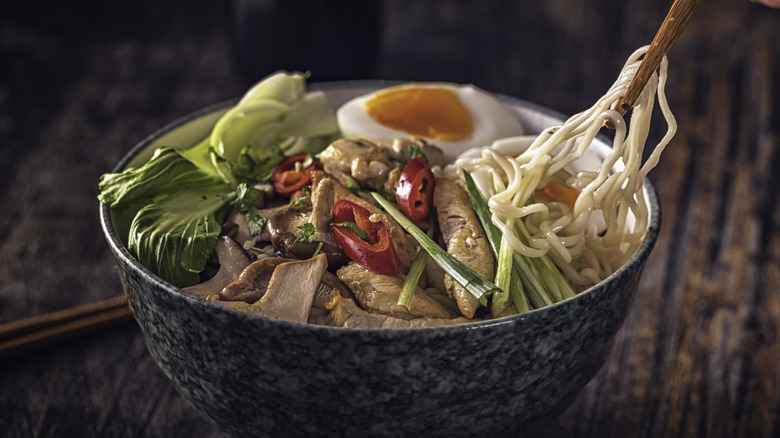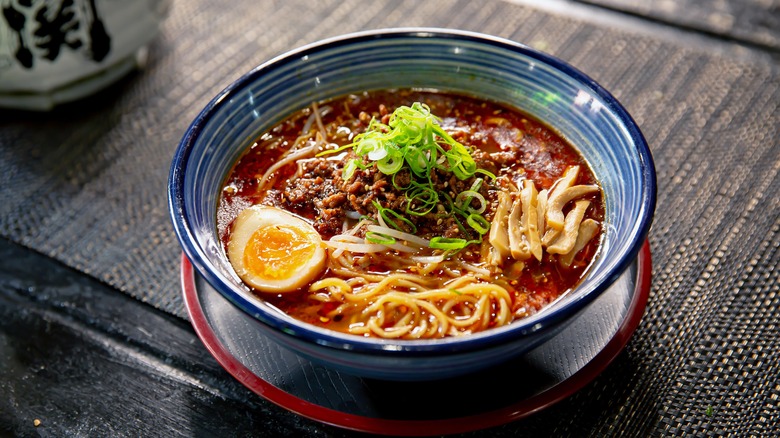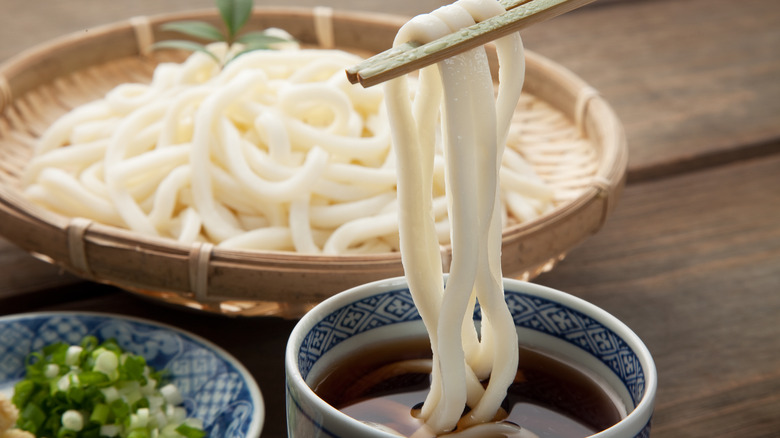Ramen Vs Udon: The Differences Between These Classic Noodles
Japanese noodle dishes are wildly popular around the world for a reason: They're absolutely delicious, in addition to being extremely varied. But there's far more than one type of Japanese noodle, and two of the most well-known — ramen and udon — are very different. While both are relatively chewy wheat noodles that you're supposed to slurp, that's about where the similarities end.
On the surface, there are plenty of obvious differences between ramen noodles and udon noodles, and you're certainly never going to mistake one for the other. Udon noodles are large, thick, and often straight — an almost-square tube that's neither flat and thin like fettuccine nor round like spaghetti. Ramen noodles, meanwhile, are (usually) thin, springy, and wavy. In addition to the obvious differences in shape, they have significant flavor differences, too. While ramen is lighter and works well in a rich broth alongside various umami ingredients, udon noodles have more flavor and bite and are typically the star of any dish.
It's not surprising they're prepared differently. Unlike ramen, udon are typically cooked then rinsed in cold water to shock them back into the right texture. And while you typically knead ramen with your hands, the traditional way to knead udon is actually using your feet.
Ramen has one typical presentation, while udon has many
While there are certainly plenty of udon noodle dishes, ramen is a particular food all to its own. In some ways, ramen as a dish actually has more in common with pho, the traditional Vietnamese breakfast dish, than it often does with its Japanese cousin. Where udon can be served in very different ways, most ramen will follow the same rough formula: ramen noodles themselves, broth, and add-ins of every shape and stripe, from meat and vegetables to cooked eggs and nori. A bowl of ramen is an infinitely customizable dish, and while it's possible to eat ramen noodles in a drier preparation (as well as putting ramen noodles in a frittata), it's much more common to see them cooked in some sort broth.
Unlike ramen, udon noodles didn't develop and coalesce around a single preparation, meaning they'll show up in a lot of different ways. Udon noodles are often served in a broth (though udon's broths tend to be lighter and thinner than those of ramen), but they don't have to be. There are numerous common preparations of udon that don't involve a traditional broth, from curry udon to yaki udon, a stir-fried dish with sauce. There's even zaru udon, a cold udon dish typically served with a dipping sauce. Cold ramen noodle dishes do exist, but they're still likely to involve a broth.
There are also ingredient differences between them
The ingredients differ, too, even though both ramen and udon are wheat noodles. Ramen dough includes egg while udon dough doesn't — but that might not even be the biggest ingredient difference between the two. While udon can be made with any type of water, ramen is prepared with kansui, a type of alkaline mineral water that gives the noodles their trademark springy texture. If kansui itself isn't available, there's also a powder that mimics it.
It's worth noting that while both ramen noodles and udon noodles can be dried, udon are notorious for not taking to the process nearly as well. Generally, dried udon noodles won't possess that signature dense, chewy texture for which they're so well-known. A lot of "instant" udon thus tends to be vacuum-sealed fresh rather than dried. Ramen generally handles the drying process much better — one of the reasons shelf-stable ramen noodles are so ubiquitous.


